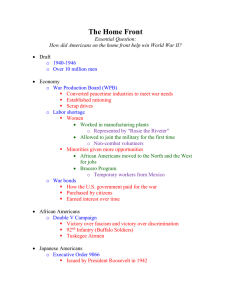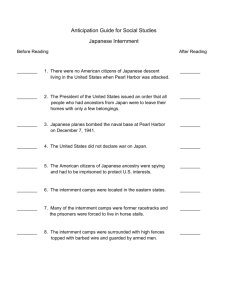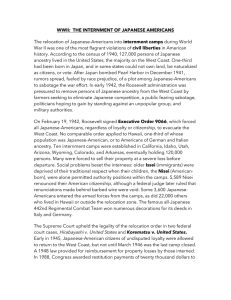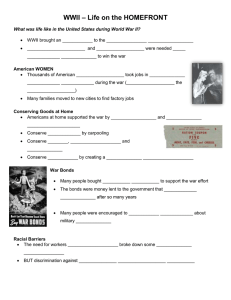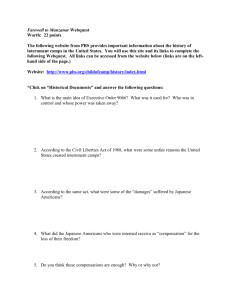Executive Order 9066 The Japanese Internment 1942-1945
advertisement
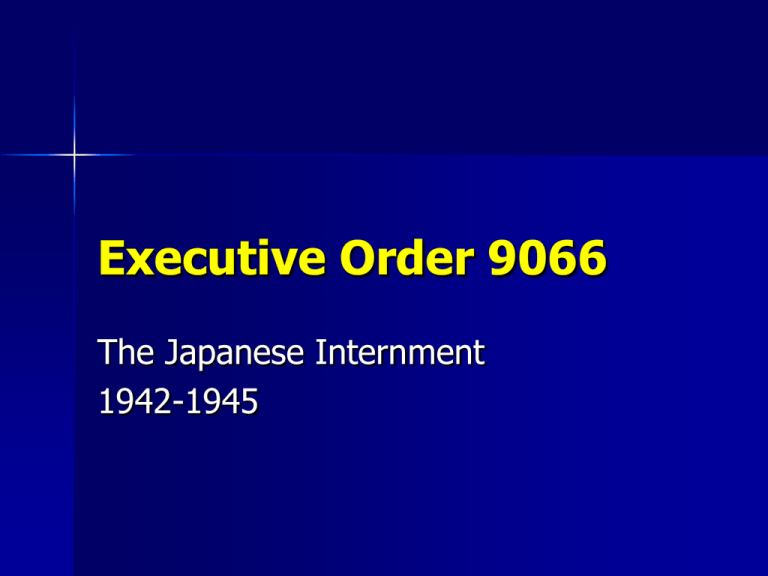
Executive Order 9066 The Japanese Internment 1942-1945 Introduction After the bombing of Pearl Harbor by the Japanese in December, 1941, the U.S. government was concerned with tightening national security. In addition, bitterness toward Japanese-Americans grew in many sectors of American society as a result of the surprise attack. Little more than two months after the Pearl Harbor attack, the U.S. government took bold and severe measures to secure the nation from what it deemed “a menace” – persons of Japanese ancestry in the western U.S. History of Discrimination Against Asians In U.S. 1882 – Chinese Exclusion Act Early 20th Century western states like California passed laws that: – – – – Denied land ownership Segregated children in public schools banned intermarriage Segregated from public places, neighborhoods, jobs, etc. Immigration Act of 1924: – No more Japanese immigration – No more “naturalization” of current legal aliens = 47,000+ in the U.S. February, 1942 President Roosevelt issued Executive Order 9066: – Designated “military areas” throughout the country – Designated “broad areas” within these areas: Removal of any or all persons who were deemed “security threats” from these areas Persons to be evacuated to “relocation” centers Map of the Areas to be Evacuated Sign posted ordering the evacuation of Japanese Americans from the West Coast The “Relocation” or “Internment” Camps General John L. DeWitt Commanding General of the Western Defense Command The continued pressure of a large, unassimilated, tightly knit racial group, bound to an enemy nation by strong ties of race, culture, custom and religion along a frontier vulnerable to attack, constituted a menace which had to be dealt with. The Relocation of Persons of Japanese Ancestry Began in March 1942 Primary areas were western parts of Washington, Oregon, and California At first the government ordered them to move outside of the “designated areas” BUT, they were no more welcome inland than on the coast – Other states did not want to become a “dumping ground for enemy aliens…” Arizona Governor The policy of “permanent camps” established: – was to include a program of work projects for which internees could receive compensation The Relocation of Persons of Japanese Ancestry Federal government assumed no liability for the property of those “relocated” Sometimes moves took place with as little as 48 hours notice Encouraged to sell what they had Business properties, homes, cars, furnishings, personal items were sold far below market value All families suffered severe losses and lives in upheaval Families were forced to sell businesses… …and pack up… …their possessions… …in order to relocate… …to the internment camps. Excerpt from Nisei Daughter by Monica Itoi Sone …On the twenty-first of April, a Tuesday, the general gave us the shattering news. “All the Seattle Japanese will be moved to Puyallup by May 1. Everyone must be registered Saturday and Sunday between 8 a.m. and 5 p.m. They will leave next week in three groups, on Tuesday, Wednesday and Friday.” Up to that moment, we had hoped against hope that something or someone would intervene for us. Now there was no time for moaning. A thousand and one details must be attended to in this one-week of grace. Those seven days sputtered out like matches struck in the wind, as we rushed wildly about. Mother distributed sheets, pillowcases and blankets, which we stuffed into seabags. Into the two suitcases, we packed heavy winter overcoats, plenty of sweaters, woolen slacks and skirts, flannel pajamas and scarves. Personal toilet articles, one tin plate, tin cup and silverware completed our luggage. The one sea bag and two suitcases apiece were going to be the backbone of our future home, and we planned it carefully. Henry went to the Control Station to register the family. He came home with twenty tags, all numbered “10710.” Tags to be attached to each piece of baggage, and one to hang from our coat lapels. From then on, we were known as family #10710… The Relocation of Persons of Japanese Ancestry The Relocation of Persons of Japanese Ancestry The Relocation of Persons of Japanese Ancestry 100,000-120,000 persons of Japanese ancestry were affected 2/3rds of them were American-born: – U.S. citizens – Nisei = first generation American born 1/3rd were legal residents (Issei) who most likely would have become citizens but were prevented from doing so by the Immigration Act of 1924 Issei & Nisei The “Relocation” or “Internment” Camps The ten camps located in remote, desolate areas of mostly the Western U.S. Camps were fenced in – military guards on the outside Dotted with tarpapered wooden barracks Each barrack consisted of several one-room apartments: – Partial walls – Furnished with cots, blankets, and a bare light bulb Single family or groups of strangers shared each room Toilets, bathing, laundry and dining facilities were communal Minimal school, recreation, and medical-care facilities provided The “Relocation” or “Internment” Camps The “Relocation” or “Internment” Camps Manzanar – Southern California The “Relocation” or “Internment” Camps The “Relocation” or “Internment” Camps In most camps construction had to be completed upon arrival. In addition, the camps were very crowded… …and were home to both young and old. Children had to attend school in cramped quarters… Life in the Camps …and had a difficult time… Life in the Camps …finding a place to play. Life in the Camps Japanese Americans were forced to work… Life in the Camps …and the camps were always monitored by guards from the U.S. Army. Life in the Camps Japanese Americans were allowed to associate with each other at times… Life in the Camps …and plant and farm their victory gardens, which supplemented their diets at the camp. Life in the Camps In some areas cold temperatures and snow had to be dealt with by people that were not used to a similar climate. Barrack Life Life in the barracks was uncomfortable as entire families lived in a single room that was sparsely furnished with cots and makeshift dressers… Barrack Life …and that offered no privacy for young married couples. Loyal to the U.S. Government Many Japanese Americans served in the United States military during World War II, while their family members were interned in a camp. Loyal JapaneseAmericans No attempt was ever made by the government to distinguish between loyal & disloyal Most all complied to prove their loyalty Some Japanese-Americans relinquished their citizenship in protest Some challenged the constitutionality in court: – Fred Korematsu – Minoru Yasui – Gordon Hirabayashi NO EVIDENCE WAS EVER DISCOVERED OF SABATOGE & SPYING Suits against the U.S. Government Hirabayashi v. United States – the U.S. Supreme Court unanimously decided that a curfew order affecting only Japanese Americans was constitutional. Korematsu v. United States – the U.S. Supreme Court upheld the order calling for the relocation of Japanese Americans as constitutional. (Ronald Reagan would sign a law in 1988 which provided some restitution for people of Japanese ancestry who were interned during World War II) Korematsu, Yasui, & Hirabayashi Release? At first, camps thought to be temporary National animosity & paranoia about sabotage convinced the government that large-scale releases not feasible To get out: – Had to prove NOT disloyal to the US – Had a community willing to accept – Had a job waiting Release? After June, 1942 (Battle of Midway Island) critics of the policy became more vocal 1943 resolution passed in Congress to segregate the loyal from the disloyal: – This allowed men and women to be released if they promised to join the armed forces – Had to swear allegiance to the US and denounce any allegiance to the emperor Many Nisei worried about leaving parents behind who could not qualify for release Many resentful 442nd Brigade – Go For Broke!!! Over 17,000 JapaneseAmericans served in the military Regiments were segregated The 442nd served with honor & distinction in Europe It is the most highly decorated regiment in U.S. military history 442nd Brigade - Go For Broke!!! Release & Restitution By the end of 1945 the camps were closed 1988 President Reagan signed restitution legislation: – $20,000 to every Japanese-American interned – Compensation for emotional suffering First payments made in October, 1990 Vindication! Minoru Yasui, Gordon Hirabayashi and Fred Korematsu challenged the right of the U.S. Government to subject only Japanese Americans to curfew and evacuation. The three men were convicted and imprisoned for violating the curfew and failing to report for evacuation. In 1944 the United States Supreme Court upheld their convictions. Vindication! In 1983 the three men filed coram nobis petitions seeking to vacate the original convictions. In November 1983 United States District Court Judge Marilyn H. Patel reversed Korematsu's conviction. The Judge found that the internment had been based on misleading and incomplete information about Japanese Americans put forth by government officials. Presidential Medal of Freedom Recipient Fred Toyosaburo Korematsu Defiant Stand for Freedom Japanese American honored years after arrest, internment Today – A National Monument Assignment Finish reading the excerpt from Nisei Daughter. Look up the text of the 5th amendment in your book (p. 159-160) Answer the questions regarding Japanese Internment on the back of Enrichment Activity 12.

